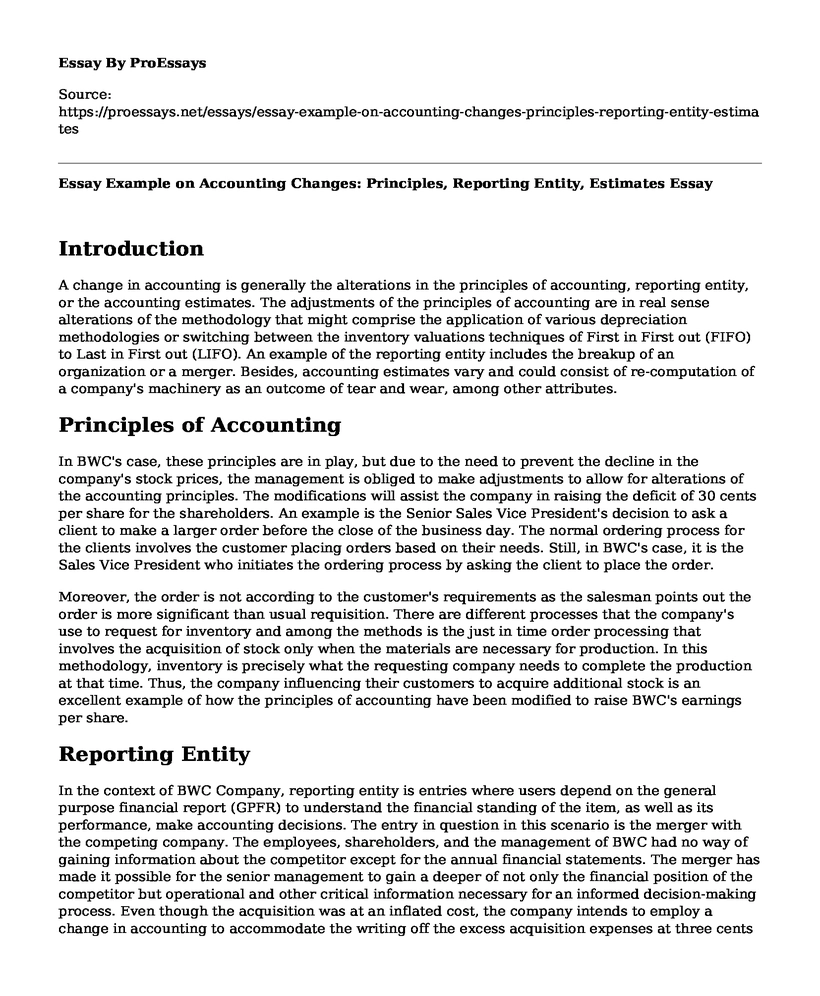Introduction
A change in accounting is generally the alterations in the principles of accounting, reporting entity, or the accounting estimates. The adjustments of the principles of accounting are in real sense alterations of the methodology that might comprise the application of various depreciation methodologies or switching between the inventory valuations techniques of First in First out (FIFO) to Last in First out (LIFO). An example of the reporting entity includes the breakup of an organization or a merger. Besides, accounting estimates vary and could consist of re-computation of a company's machinery as an outcome of tear and wear, among other attributes.
Principles of Accounting
In BWC's case, these principles are in play, but due to the need to prevent the decline in the company's stock prices, the management is obliged to make adjustments to allow for alterations of the accounting principles. The modifications will assist the company in raising the deficit of 30 cents per share for the shareholders. An example is the Senior Sales Vice President's decision to ask a client to make a larger order before the close of the business day. The normal ordering process for the clients involves the customer placing orders based on their needs. Still, in BWC's case, it is the Sales Vice President who initiates the ordering process by asking the client to place the order.
Moreover, the order is not according to the customer's requirements as the salesman points out the order is more significant than usual requisition. There are different processes that the company's use to request for inventory and among the methods is the just in time order processing that involves the acquisition of stock only when the materials are necessary for production. In this methodology, inventory is precisely what the requesting company needs to complete the production at that time. Thus, the company influencing their customers to acquire additional stock is an excellent example of how the principles of accounting have been modified to raise BWC's earnings per share.
Reporting Entity
In the context of BWC Company, reporting entity is entries where users depend on the general purpose financial report (GPFR) to understand the financial standing of the item, as well as its performance, make accounting decisions. The entry in question in this scenario is the merger with the competing company. The employees, shareholders, and the management of BWC had no way of gaining information about the competitor except for the annual financial statements. The merger has made it possible for the senior management to gain a deeper of not only the financial position of the competitor but operational and other critical information necessary for an informed decision-making process. Even though the acquisition was at an inflated cost, the company intends to employ a change in accounting to accommodate the writing off the excess acquisition expenses at three cents per quarter.
Accounting Estimates
The senior management meeting also adopted the approximation of the amount to be credited or debited on entries that have no accurate estimations. Such entries comprise the annual maintenance, extraordinary maintenance, costs of bad debts, as well as the remaining shares. There are deliberate accounting estimates made to ensure that the EPS increases to the desired promise to the shareholders. For instance, annual maintenance involves judgment concerning the anticipated gains of the company's assets and liabilities. Hence, the estimations of the maintenance costs are subjective and require re-estimation and revisions to permit BWC to realize the additional two cents. Furthermore, the company was able, in its previous quarter, to defer two cents despite the quarter being the heaviest in maintenance.
Currently, the cost of annual maintenance should decline as in the most challenging period of support passed with only two cents less from the yearly expense of eight cents per share. Similarly, the extraordinary maintenance costs are eight cents, which the senior management meeting thought fit to diverge it to the current financial period even though the maintenance has no guarantee of prolonging the tear and wear of the machinery. The foundation of the extraordinary maintenance estimates originate from the senior engineer who holds the view that overall maintenance costs will decline in the next 24 months of operation.
Reconciliation of Adjusted EPS Numbers
The reconciliation process for BWC of the adjusted earnings per share consists of the net income together with the after-tax effect of deferring financial expenses inclusive of other non-repeating costs approved by the senior management meeting for the end of the quarter audited statements of finance. The reconciliation of the adjusted EPS adhered to the generally accepted principles of accounting and was in-line with the company's financial statements, as depicted in table 1.
End of Quarter (cents)
- Earnings per share 60
- Annual Maintenance 4
- Extra Ordinary Maintenance 8
- Land donation 1
- Depreciation of Heavy equipment 2
- Purchase of Competitor 3
- Unused shares 4
- Bad debt expense 2
- Large Emergency Order 2
- Unearned Revenue 4
- Adjusted EPS 90
Cite this page
Essay Example on Accounting Changes: Principles, Reporting Entity, Estimates. (2023, Apr 09). Retrieved from https://proessays.net/essays/essay-example-on-accounting-changes-principles-reporting-entity-estimates
If you are the original author of this essay and no longer wish to have it published on the ProEssays website, please click below to request its removal:
- Profitability of the Business Paper Example
- Article Review on ACO and Populations Health Management
- H.G. Gets Central Line for Osteomyelitis Treatment
- Essay Example on Maximizing Cost Efficiency: The Benefits of Life-Cycle Cost Analysis (LCCA).
- Ins. Agency Execs: ML Team to Predict Customer Acceptance of Quote
- Essay Example on Creating an Equitable Payment Plan: Dessler's Five-Step Process
- Paper Example on Cash Flow Statement: Sources & Usage of Cash from Regular Biz Activities







